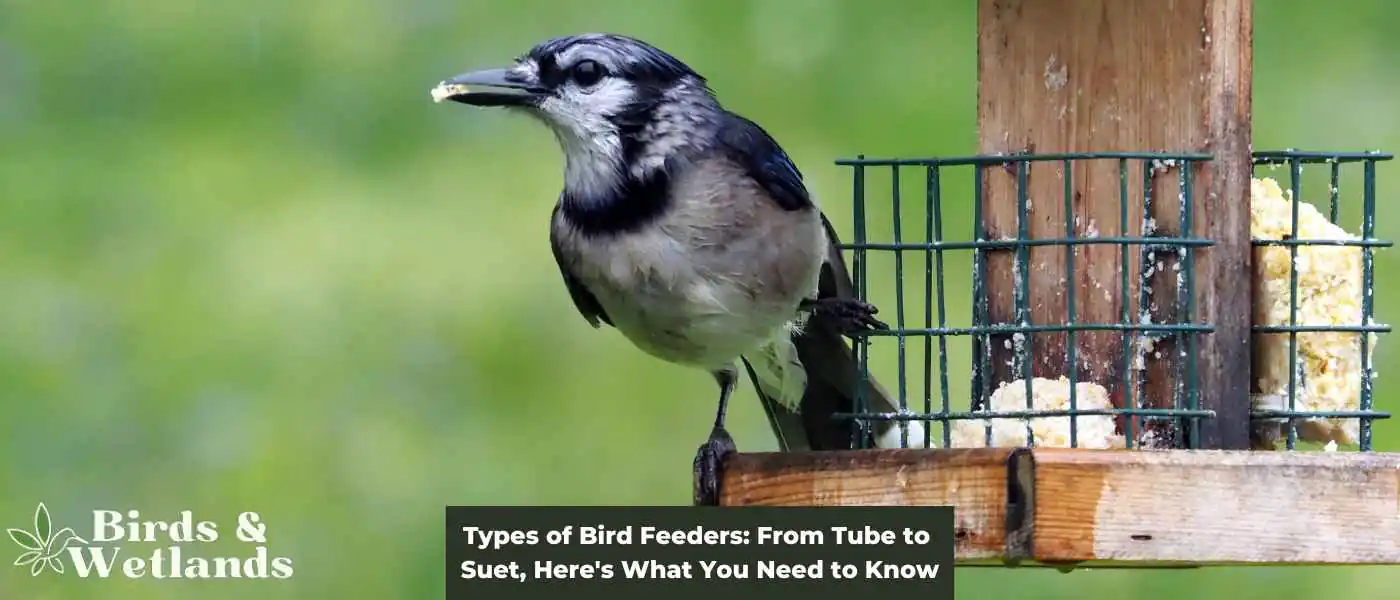Bird feeders come in various types to cater to different bird species. Tube feeders are ideal for small seed-eating birds like finches and chickadees. Hopper or house feeders attract a wide variety, including sparrows and jays. Suet feeders cater to woodpeckers and nuthatches. Nyjer or thistle feeders are designed for finches, and hummingbird feeders contain liquid nectar. Lastly, platform or tray feeders attract a diverse range of bird species but require frequent cleaning.
Key Takeaways On Different Types Of Bird Feeders
Bird Feeders Things to Consider
If you’re planning on setting up a bird feeder in your yard or garden, there are several things you’ll want to consider. Here are some key points:
- Type of Feeder: The type of feeder you choose can determine what kind of birds you’ll attract. For example, tube feeders are great for small birds like finches and chickadees, while hopper or house feeders attract a wide variety of birds. Suet feeders are ideal for insect-eating birds like woodpeckers and nuthatches.
- Food Choice: Different birds have different dietary preferences. Sunflower seeds attract a wide variety of birds, while nyjer (thistle) seeds are favored by finches and siskins. Suet cakes can attract a variety of birds, particularly in the colder months.
- Feeder Location: Locate your feeder in a quiet, safe place. It should be near enough to tree cover that birds can escape predators, but far enough away that predators cannot use it to launch an attack. It’s also beneficial if the feeder is positioned where you can see it, for your own enjoyment.
- Maintenance and Cleanliness: Feeders need to be cleaned regularly to prevent the spread of disease. Choose a feeder that you can easily disassemble and clean. You should clean your feeder with hot soapy water and rinse it thoroughly at least every two weeks.
- Protection Against Squirrels and Rodents: Squirrels, rats, and other rodents can be a nuisance at bird feeders. Consider feeders with squirrel-deterring designs, or add a baffle (a dome-shaped obstacle) above or below the feeder to prevent access.
- Durability and Weather Resistance: Choose a feeder that can withstand your local weather conditions. It should be durable and preferably with some form of cover to protect the seeds from getting wet.
- Seed Capacity: Depending on how many birds you plan to feed and how often you want to refill, the capacity of the feeder can be an important factor. Larger feeders will need to be filled less often.
- Ease of Filling: Choose a feeder that is easy to refill. Some feeders have removable tops or sides that allow for easy access.
- Water Supply: Birds need fresh water for drinking and bathing. Having a water source near your feeders can attract more birds.
- Bird Safety: The feeder should not have any sharp edges or points, and it should not have any small, inescapable areas where a bird could get trapped.
Suet Feeders
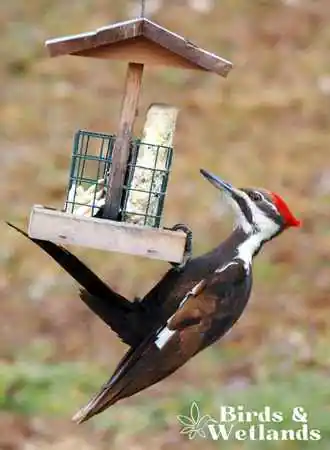
Suet feeders or suet cages are specially designed to feed birds with energy-rich food during the winter months. These feeders are popular among bird enthusiasts due to their unique features and benefits. However, they also have some drawbacks to consider before investing in one.
A suet feeder or suet cage is bird feeder type made from durable materials like wood or metal and have a wire mesh or plastic cage to hold the suet. The cage deter squirrels and allows smaller birds to cling and feed.
Suet feeders can attract a wide range of bird species, including woodpeckers, nuthatches, chickadees and insect-eating birds.
While suet feeders have many benefits, there are some drawbacks to consider. One of the main drawbacks is the mess they can create. Suet can become greasy and messy, attracting unwanted insects or rodents to your yard.
Suet can melt in warm temperatures, making it less appealing to wild birds and creating a mess in your yard. Also, some suet feeders are more difficult to clean than other bird feeders due to their design, which can be a problem if you want to maintain a clean feeding station.
Wild Bird Copper Suet Feeder
A Must-Have for Bird Lovers
- Triple Capacity: Hold up to 3 cakes or a large brick for continuous bird feeding.
- User-Friendly: The EZ Fill design ensures effortless reloading of bird feed.
- Weather-Proof: Its unique roof design keeps feed dry, ensuring birds can feast in any weather.
- Comfort-First Design: The vinyl coating prevents birds’ feet from freezing in winter or burning in summer.
Hopper Feeders
Squirrel-proof hopper feeders are some of the best bird feeders, designed to hold large quantities of seed. They have a distinctive shape that resembles a hopper or a container, and is particularly good at protecting seeds from weather and bird droppings. As birds eat, seeds fall down from the hopper.
Squirrel resistant hopper feeders come in a variety of sizes and styles and are made from different materials such as wood, plastic or metal. You can use a small hopper feeder to attract small birds.
One of the key features of a hopper feeder is its ability to hold a large quantity of birdseed, which makes them perfect for bird enthusiasts who don’t want to refill their feeders frequently.
Hopper feeders are often built with a roof to protect the bird seed from rain, snow or wind, which keeps the seeds dry and fresh for longer periods. They are usually designed with multiple perches or feeding stations, which allow birds to feed comfortably without having to compete with each other.
These feeders are a popular choice for bird enthusiasts because they attract a wide variety of birds, such as finches, house sparrows, chickadees, mourning doves, cardinals and other backyard birds, which makes bird watching more interesting.
However, these feeders are also squirrel magnets so get one that has a squirrel baffle or come in a wire cage. While these feeders have a large capacity, they still need to be refilled frequently, especially during the winter months when birds need more food.
Nature’s Rhythm Metal Hopper Bird Feeder
A Sturdy Dual-Seed Paradise for Wild Birds
Turn your garden into a birds’ haven with Nature’s Rhythm Metal Hopper Bird Feeder, the ultimate feeding station designed with dual compartments and multiple ports.
- Generous Capacity: Dual seed compartments can store up to 10 pounds of bird feed.
- Versatile Feeding: With 10 ports, a mesh screen, and a wrap-around tray, birds can feed from various angles.
- Durable Design: The all-metal, copper-toned body with powder-coated finish ensures resilience against weather conditions.
Platform Feeders
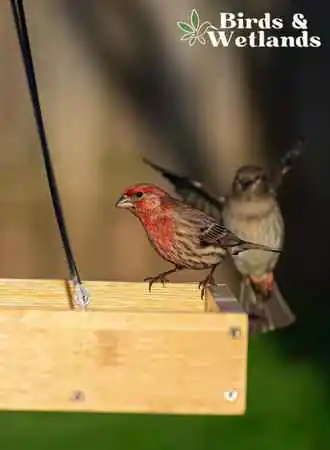
Platform feeders are a great option for bird lovers and homeowners who want to attract many birds to their yards or garden. These feeders are typically designed with a flat surface where birdseed, fruits, or nuts can be placed.
Platform feeders come in various sizes and designs, but they all share some common features, including a flat surface, an open design, ease of filling with food, and easy cleaning.
The flat surface of the platform feeder allows birds to easily access the food, making it easy for them to feed. The open design of platform feeders makes it easy for multiple birds to feed simultaneously. They are easy to fill with food and can be cleaned quickly using soap and water.
However, platform feeders also have some drawbacks. They are exposed to the elements, which can spoil the food or make it less appealing to birds. Unlike tube feeders or hopper feeders, platform feeders offer limited protection against squirrels or other animals that may try to steal food.
Kingsyard Adjustable Platform Bird Feeder
A Versatile Sanctuary for Your Feathered Friends
- Customizable Experience: Adjustable height offers control over the size of visiting birds.
- Squirrel-Proof: Unique top system spins to deter squirrels, keeping the feed solely for the birds.
- Versatile Feeding: Drainage holes maintain seed freshness while accommodating different seed types, attracting a wide range of birds.
Tray Feeders or Ground Feeders
Tray bird feeders are a type of bird feeder that consists of a flat surface or tray that holds safflower seed mixes, mixed seed, nuts, or other food. They are a popular choice for bird enthusiasts because they are easy to use and maintain and provide a clear view of the birds that visit them.
One of the key benefits of a tray feeder is its versatility. They can be placed on the ground or on a pole, and they can hold various types of food. Some tray feeders have multiple compartments, allowing you to offer different foods to attract a wider range of bird species.
Another advantage of tray bird feeders is that they are easy to clean and maintain. The tray’s flat surface makes it easy to remove any leftover food or debris, and many tray feeders are made of durable materials that can withstand exposure to the elements.
When choosing a tray feeder, buy one that has drainage holes.
Hummingbird Feeders or Nectar Feeders
Hummingbird feeders, also known as nectar feeders, are devices used to attract and feed hummingbirds. These small, colorful birds have a high metabolism and require a lot of energy to sustain their quick movements. A nectar feeder provides them with an easily accessible source of food, especially during times when natural sources of nectar may be scarce.
Nectar feeders typically consist of a container or reservoir for holding the nectar and a feeding port or ports for the hummingbirds to access the nectar.
The container is usually made of plastic or glass and may have a capacity of several ounces to several cups, depending on the size of the feeder. The feeding ports are usually made of plastic and may be shaped like flowers or other natural shapes to attract hummingbirds.
Kingsyard Glass Hummingbird Feeder
Attract More Hummingbirds to Your Outdoor Space
- Attractive Design: High-quality glass container with 6 flower-shaped feeding ports welcomes multiple hummingbirds simultaneously.
- Ease of Use: The wide-mouth bottle design ensures easy filling and cleaning with a fully disassemblable structure.
- Ant Moat Included: High-quality ant moat with stainless steel hook protects feeder from pesky ants and ensures easy hanging.
The nectar used in these feeders is typically made by mixing sugar and water in a ratio of 4:1 or 3:1 (four or three parts water to one part sugar). Boiling the mixture for a few minutes can help dissolve the sugar and prevent the growth of harmful bacteria.
Using only plain white granulated sugar in the nectar is important, as other types of sugar or sweeteners can harm hummingbirds. Red food coloring should also be avoided, as it is unnecessary and may be harmful.
When setting up a hummingbird feeder, it is important to place it in a location that is easily visible to the birds and away from windows or other obstacles that may cause collisions.
It is also important to keep the feeder clean and well-maintained, as mold and bacteria can grow in the nectar and be harmful to the birds.
Feeder ports should be cleaned regularly with a solution of one part white vinegar to four parts water, and the nectar should be changed every few days or more frequently in hot weather.
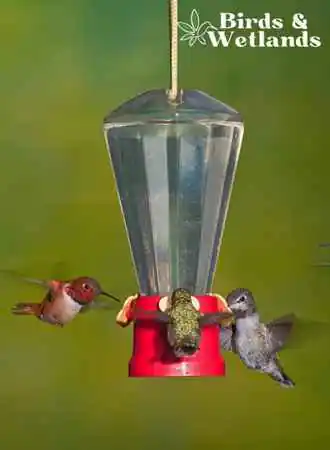
Thistle Feeders or Nyjer Feeders
Thistle feeders and nyjer bird feeders are types of bird feeders specifically designed to hold thistle seed or nyjer seed, which are small, oily seeds favored by seed-eating birds.
This tube feeder typically consists of a small tube or mesh sock holding the seed and small feeding ports for the birds to access the seed. This tube feeder is designed to prevent the seed from spilling or getting wet, which can attract pests or cause the seed to spoil.
Nyjer is a type of seed that is imported from Africa and is also known as nyjer. It is a favorite of many finches, such as purple finches and house finches, as well as other small birds like pine siskins and redpolls. Thistle seed is a general term for the small seeds of various thistle species, and while it is similar to nyjer in size and appearance, it is less commonly used as bird feed.
Metal Thistle Feeder
The Metal Bird Feeder Thistle Bird Feeder with its functional simplicity and quality metal construction offers an effortless way to attract a variety of birds to your garden.
- Spacious Design: Can hold up to 1.5 lb Nyger Seed or Finch Mix and features six standing ports to accommodate multiple birds.
- Durable and Weather-Proof: Quality metal construction with a copper brush finish ensures resistance against rust and all-weather durability.
- Easy to Refill and Clean: Comes with a lift-lid for easy filling and a transparent seed compartment for timely replenishment.
Tube Feeders
Tube bird feeders consist of a clear or opaque cylindrical tube, often made of plastic or glass, with feeding ports and perches for birds to access the food inside. The tube is typically suspended from a hanger or a pole, and the bird food is poured into the top of the tube and held in place by a cap or a lid.
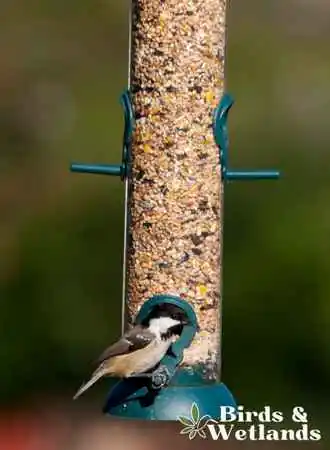
Tube bird feeders can come in different sizes and designs, with various numbers of feeding ports and perches. Some tube feeders are designed for tree branches and may have additional features like squirrel-proofing mechanisms, built-in sunflower seed trays, or weather guards to protect the food from rain or snow.
These types of feeders are popular among backyard bird watchers because they are easy to clean, can hold a large quantity of food, and can accommodate a variety of bird species, from small finches to larger birds like cardinals and blue jays.
The clear tube allows for easy monitoring of the food level and bird activity, providing an enjoyable and educational experience for bird enthusiasts.
Metal Tube Bird Feeder
An Elegant Solution for Bird Watching Enthusiasts
- Robust Design: Made with powder-coated metal and acrylic, it’s rust-proof, bite-resistant, and squirrel-proof, offering a safe feeding space for birds.
- Large Capacity: Can accommodate 2 pounds of various seeds, with a lift-top for easy refill.
- Perfect for Multiple Birds: The feeder has 4 feeding ports with U-shaped perches, enabling multiple birds to feed simultaneously.
Oriole Feeders
Oriole feeders are specialized bird feeders designed to attract and feed orioles, a brightly colored bird species found in North and South America. These feeders typically feature bright colors such as orange or red, which are attractive to orioles, and are designed with a specific shape and size to accommodate their unique feeding habits.
Oriole feeders are often filled with a sugary solution called nectar, which orioles enjoy, and may also be filled with other foods such as jelly or fruit. They can be hung from a tree or pole and should be placed in a visible location that is easily accessible to orioles.
Window Feeders
Window feeders are a type of bird feeder that you attach to your window with suction cups. They’re a great way to watch birds up close while they eat. You can fill the window feeder with birdseed, suet, or even fruit. They come in different shapes and sizes and can be made of plastic, wood, or metal.
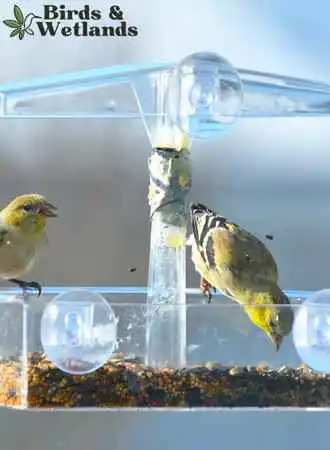
Peanut Feeders
Peanut feeders are bird feeders that are specifically designed to hold peanuts. These feeders can be hung in trees, on poles, or even on window sills. They are a great way to attract birds like woodpeckers, jays, and chickadees that love to eat peanuts. Peanut feeders are usually made of mesh or wire so that most birds can cling to them while they eat.
Related Questions
What is the best type of feeder for attracting ground-feeding birds?
If you’re looking to attract ground-feeding birds to your backyard, the best type of feeder to use is a ground feeder. This type of feeder sits directly on the ground and provides birds with easy access to hulled sunflower seeds, grains, and other types of bird food.
Ground feeders can come in a variety of designs, from simple open trays to more complex models with mesh bottoms that allow water to drain away. When choosing a ground feeder, look for one that is sturdy and easy to clean.
Consider placing it in an area that is sheltered from the wind and other elements, and that is relatively open so that birds can see any potential predators approaching.
Some examples of foods you can offer ground-feeding birds include black oil sunflower seeds, millet, cracked corn, and mealworms. You can also scatter food directly on the ground to make it easier for birds to find. However, be sure to clean up any spilled seed regularly to prevent mold growth and the attraction of rodents.
Black Oil Sunflower Seed
- High Nutrient Content: The Blue Seal Premium Black Oil Sunflower Wild Bird Seed is high in fat and protein, providing essential nutrients to wild birds especially during harsh winter months.
- Attracts Diverse Species: The seeds are known to attract a wide variety of wild birds, such as Northern Cardinals, Tufted Titmice, Mourning Doves, and Evening Grosbeaks, thereby enhancing your bird-watching experience.
- Increased Survival Rates: The presence of these bird seeds in your feeder can increase bird survival rates by up to 38%, contributing to the conservation of local bird populations.
- Promotes Overall Health: Offering a consistent and reliable source of feed like this can lead to less stress and greater overall health in the bird population visiting your garden.

